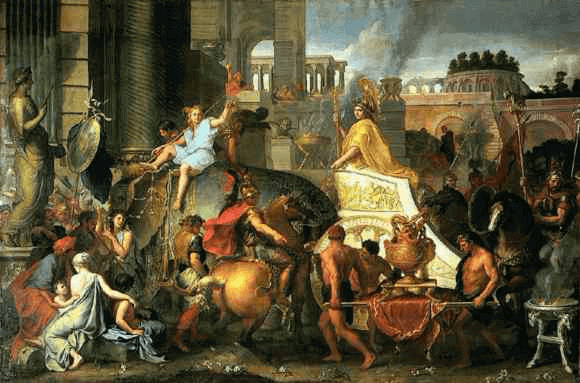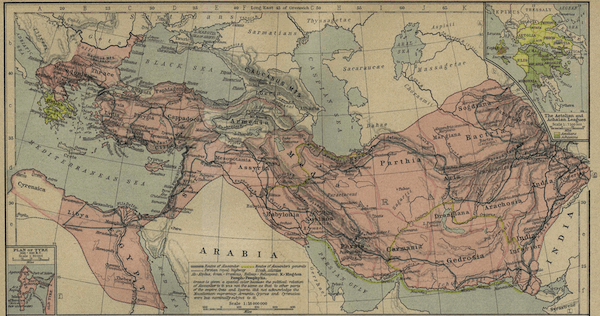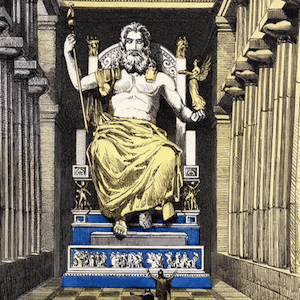Structures > Hanging Gardens of Babylon
Hanging Gardens of Babylon

Background
So now we are back at square one. There definitely existed a Hanging Gardens at Nineveh and at the same time the actual Babylon was leveled to the ground and the remnants thrown across the landscape. However, Greek writers talk about this structure as if it exists in the present. This could only be if they were built within the resurrected Babylon of Nebuchadnezzar II as Nineveh was destroyed and abandoned nearly 300 years before.
Yet no archaeological evidence for this structure has yet to be found anywhere near the palace, nor does it even seem physically possible they could have created this project at this location. So are the Hanging Gardens of Babylon a legend and simply an imagined or misguided garden yet to be found?
The answer to this mystery lies with one of the most mysterious people in history himself, Alexander the Great. Note the structure in the background of this painting.

Alexander in Babylon - Charles le Brun (1665)
Around 320 BC Alexander and his army began marching through the Middle East on a quest to drive straight at the heart of the Persian Empire. Capturing the coveted city of Babylon, according to accounts, Alexander the Great's army passed by the Hanging Gardens along with the Tower of Babel upon their conquering of the city. This would only make sense if the gardens existed in New Babylon as Old Babylon and Nineveh were both destroyed and abandoned at this point.
Alexander's documents mention the existence of the gardens so what is going on? Is the two garden theory true and the Palace/Gardens at Babylon were actually inspired by the gardens at Nineveh from hundreds of years before? Since we really only have the foundation and a very limited Babylon could we simply be missing the gardens cause the archaeological record is limited?

Alexanders Empire (336-323 BCE) Historical Atlas (1923)
The legend gets even more mysterious as Alexander the Great may have died at the Hanging Gardens as well. After conquering Babylon he occupied Nebuchadnezzar II's old palace and possible Hanging Gardens location. It was to be his staging ground for a campaign to wipe the Persians off the map. However under mysterious circumstances Alexander the Great died in Babylon from poisoning or an illness in 323 BC, only a few years after he managed to really become ruler of the ancient world. His illness and death are a mystery all of itself.
Tomb of Alexander the Great has never been located as well. Alexander the Great is pretty much the focal point for a lot of ancient mysteries.
End of Babylon
However, according to legend Alexander is known to have wanted to die within the Gardens. Other documents say he is known to have died in the Palace of Babylon after a massive feast on June 1st of 323 BC. So does this mean that the Hanging Gardens were at Babylon the whole time? Then how did researchers and archaeologists not recover any evidence?
After Alexander the Great's death his generals fought over who would gain control over the empire in the Wars of the Diadochi. Alexander the Great infamously said before he died it should go to the strongest, and they all each assumed it was them. A war broke out and Babylon was right in the center of it. Facing constant internal strife for years the city slowly deteriorated over time as the residents fled for safer places. Babylon was eventually controlled by Seleucus I Nicator who established the Seleucid Empire in the region of eastern Asia.

Babylon Fallen - Gustave Dore
According to a tablet discovered the population of Babylon was transported to the new Hellenistic capital city of Seleucia in 275 BC, which would have meant the final end for the city of Babylon. Without the workforce and man power necessary to operate something as intense as the gardens the structure could not have continued to exist and most likely fell into ruin along with the rest of the city. As the people abandoned the canals necessary to sustain life in the region the entire area gradually turned back into desert and the ruins of their city buried underneath the sands.
Seven Wonders of the Ancient World
Hellenistic Greece
- Library of Pergamon
- Colossus of Rhodes
- Ancient Theatre of Ohrid
- Tomb of Alexander the Great
- Tomb of Philip II
- Temple of Artemis at Ephesus
- Pergamon Altar
- Philippeion
- Sanctuary of the Great Gods
- Ploutonion at Hierapolis
- Filippeios Krini
Ptolemaic Structures
- Pharos Lighthouse at Alexandria
- Cleopatra's Palace at Alexandria
- Library of Alexandria
- Serapeum
- Caesareum of Alexandria
- Tomb of Antony and Cleopatra
Seleucid Structures
Indo-Greek Structures
Babylonian Structures
Other
- Gates of Alexander
- Kapilikaya Rock Tomb
- Birtha
- Tombs of the Kings of Pontus
- Monument of Prusias II
- Mausoleum of Halicarnassus






